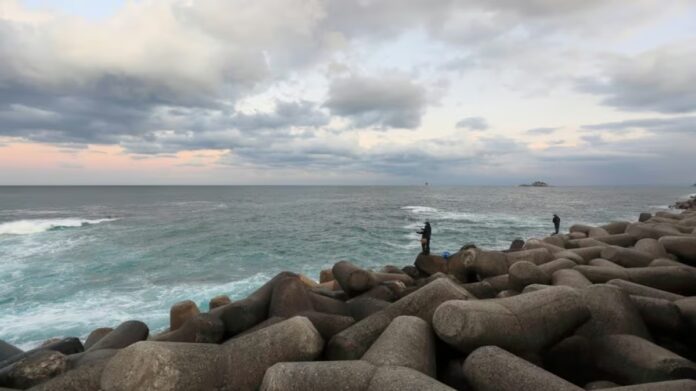Marine Drive Tetrapods are undergoing a historic upgrade as the Brihanmumbai Municipal Corporation (BMC) replaces the ageing structures with M40 models to enhance coastal protection for the next century. First installed in the 1960s, these tetrapods have protected Mumbai’s iconic Marine Drive from erosion and wave impact for over 60 years but have now reached the end of their lifespan. This ₹43.61 crore project aims to safeguard Marine Drive and address challenges posed by deteriorating tetrapods and recent climatic events.
Why Marine Drive Needs New Tetrapods?
The original tetrapods, made of M20-grade cement, were designed to last 40 years. However, decades of exposure to harsh marine conditions and the impact of Cyclone Nisarga have left them weakened and damaged.
- Initial Installation: The tetrapods were first installed between 1960 and 1965, with additional replacements from 1982 to 2002.
- Visible Deterioration: Ageing structures and recent cyclonic events have caused erosion and structural damage along the Marine Drive coastline.
- Coastal Road Impact: The removal of tetrapods during the Coastal Road project temporarily exposed parts of Marine Drive to direct wave impacts, prompting urgent replacement plans.
M40 Tetrapods: The Future Of Coastal Protection
The new M40 tetrapods are built using stronger M40-grade cement, offering a significant improvement in durability and efficiency.
- Enhanced Durability: These structures are designed to last up to 100 years, ensuring long-term coastal protection.
- Improved Functionality: The tetrapods are engineered to break the force of waves more effectively, reducing erosion and minimizing damage to Marine Drive.
- Addressing Vibrations: Residents had previously complained of vibrations caused by crashing waves. The new tetrapods aim to mitigate this issue by absorbing wave energy efficiently.
The ₹43.61 Crore Upgrade Plan
This ambitious project by the BMC involves the complete replacement of existing tetrapods along Marine Drive.
- Budget Allocation: The project has been allocated ₹43.61 crore, covering the manufacturing and installation of new tetrapods.
- Completion Timeline: The upgrade is expected to be completed by May 2025.
- Scope Of Work: The new tetrapods will be installed strategically to enhance protection and preserve the visual appeal of Marine Drive.
The Importance Of Tetrapods In Coastal Defense
Tetrapods play a vital role in protecting coastal areas from erosion and wave impact:
- Wave Dissipation: The unique four-legged design of tetrapods disperses wave energy, reducing its impact on the coastline.
- Erosion Prevention: By breaking the force of waves, tetrapods prevent soil erosion and protect infrastructure near the coast.
- Historical Significance: Marine Drive’s tetrapods have become synonymous with Mumbai’s coastline, serving as both functional structures and iconic symbols.
Cyclone Nisarga And The Need For Resilience
Cyclone Nisarga in 2020 highlighted the vulnerabilities of the ageing tetrapods, causing significant damage to the structures and the coastline.
- Temporary Measures: Following the cyclone, BMC reinstalled some tetrapods to address immediate concerns.
- Permanent Solution: The new M40 tetrapods are designed to withstand similar climatic events, providing a durable solution for future challenges.
Impact On Marine Drive And Surrounding Areas
The replacement of tetrapods is expected to benefit Marine Drive and its residents in multiple ways:
- Preservation Of Heritage: As one of Mumbai’s most iconic landmarks, maintaining Marine Drive’s structural integrity and aesthetic appeal is crucial.
- Enhanced Safety: Stronger tetrapods will ensure better protection for the promenade and nearby structures, safeguarding residents and visitors.
- Mitigation Of Vibrations: The improved design of the tetrapods will address the issue of vibrations caused by waves, enhancing the quality of life for residents along Marine Drive.
A Brief History Of Marine Drive Tetrapods
The tetrapods were first introduced in Mumbai between 1960 and 1965 to protect Marine Drive from the Arabian Sea’s relentless waves.
- Subsequent Replacements: Over the years, additional tetrapods were installed to reinforce the coastline, particularly between 1982 and 2002.
- Iconic Status: These structures have become a defining feature of Marine Drive, attracting tourists and serving as a symbol of Mumbai’s resilience.
BMC’s Vision For Coastal Protection
The tetrapod replacement project aligns with BMC’s broader vision for strengthening Mumbai’s coastline:
- Integration With Coastal Road Project: The upgraded tetrapods complement the ongoing Coastal Road project, ensuring seamless protection for the city’s western coastline.
- Sustainable Infrastructure: By investing in durable materials like M40-grade cement, the BMC is promoting sustainability and cost-efficiency in urban infrastructure.
- Preparedness For Climate Change: The project reflects the city’s commitment to adapting to climate challenges and protecting its coastal areas.
Looking Forward
As the tetrapod replacement project progresses, it marks a significant step toward securing Mumbai’s coastline for future generations. The new M40 tetrapods symbolize the city’s resilience and commitment to preserving its heritage while embracing modern solutions. With the project slated for completion by May 2025, Marine Drive is set to remain a cherished landmark, offering protection and beauty for the next century.



